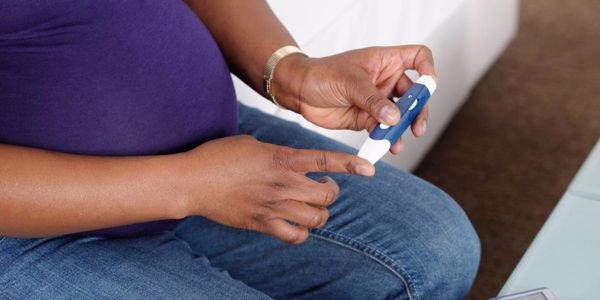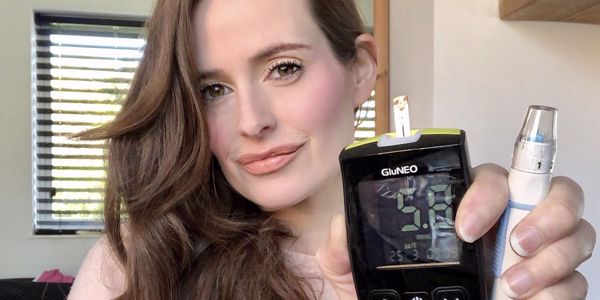During your first appointment with the midwife, you'll be asked a few questions to determine whether you qualify for glucose testing for gestational diabetes (GD).
To decide if you're at an increased risk of GD, They'll chat with you about your medical history, whether you've had it before or if you've given birth to a baby weighing over nine pounds. They'll also consider your age, BMI, lifestyle and family history in general in order to decide whether you might benefit from being screened.
My dad has type 2, and my uncle has type 1 so that alone qualified me for a gestational diabetes glucose screening test.
What Is an Oral Glucose Tolerance Test? (OGTT)
When I was pregnant with Billy, it was called a 'GTT' 'glucose tolerance test.' It's now called an 'oral glucose tolerance test' (OGTT). The process takes about two hours.
The OGTT will happen when you're between 24 and 28 weeks pregnant. If you've had gestational diabetes before, you'll be given an OGTT earlier in your pregnancy and another one at 24 to 28 weeks if the first test is normal.
What Does An OGTT Involve?
You'll need to fast for eight to ten hours before your morning blood test (check with your midwife on how much water you can have), and then you'll be given a glucose drink.
Back in the day, it used to be a bottle of Lucozade (I tested borderline back in 2017 with my first using this method), but by the time I was pregnant with my second child in 2018, they'd upgraded this to a specific drink that they supply within the hospital, and I tested positive.
After resting for two hours after the glucose drink, your midwife will take another blood sample to see how your body is coping. If your blood glucose is over a certain level – you'll be diagnosed with gestational diabetes.
The NICE guidelines in England and Wales state that if a woman has gestational diabetes if she scores either:
- a fasting plasma glucose level of 5.6mmol/l or above or
- a two-hour plasma glucose level of 7.8mmol/l or above
I scored 3.9 and 8.6. My results meant I could try managing my GD through diet, and for anybody looking to do this, please head to Gestational Diabetes UK and join their brilliant Facebook support group.
The GD diet is challenging, and the NHS guidelines don't really cut it.
What Happens if I Have Gestational Diabetes?
It is possible to control your sugars through dietary changes, but I'm not going to lie; it's hard. You'll find it's a trial and error process. In fact, depending on your test results, you may also need to take medicine/insulin to help keep things under control.
First things first. Put down the chocolate.
Living with gestational diabetes involves a massive dietary overhaul, so you'll need to tweak your diet to control your blood sugar levels. Carbs and sugar are both ridiculously restricted.
I had corn on the cob once; it was a big mistake. Cereal for breakfast? Not happening. Bread? Forget it. Pasta? Potatoes? All a no-go in large amounts – and for some, any amount.
So what's left? I hear you cry. Meat, green veg, fats and nuts. I was tested for gestational diabetes in my 28th week of pregnancy, and when the test came back positive, I'll admit, I sobbed. I was mid-piece of Dairy Milk when my mobile rang.
How To Control Blood Sugar During Pregnancy
If you're diagnosed with OGTT, you'll get a blood sugar testing kit to monitor your blood sugar four times a day. First, upon waking, one hour post breakfast, lunch and dinnertime. Yep, welcome to the fun world of finger prick testing!
The GluNeo blood glucose monitoring system was to be my faithful companion for the rest of my pregnancy until I gave birth. It came with a sharps bin for pins, a lancet to load the pins onto, and a tiny cylinder of strips to absorb the blood. It also came with a record book for the results to be recorded to track progress.
Top finger pricking tip: rotate your fingers and thumbs so you're not over-pricking in one place.
GD is scary, but the good news is that you'll be closely monitored throughout your pregnancy and birth to avoid potential problems. Glucose results can be hard to control, especially if you become ill with a cold or virus.
If you're worried about your results spiking – and they'll let you know the numbers they'll want to be seeing – contact them immediately. You'll probably be assigned a diabetes nurse - stick them on speed dial.
Other Things To Know
If you're managing gestational diabetes during pregnancy, your consultant may want to plan delivery before hitting the 41-week mark. Sometimes, your midwife and team might suggest kickstarting labour or opting for a C-section if things aren't progressing naturally by then.
This is to minimise any potential risks associated with larger babies and other complications related to gestational diabetes. You may also be advised to colostrum harvest, which helps newborns regulate any sugars that might find themselves out of whack.
A diagnosis of gestational diabetes is tough, but with the right support, you'll get through with no issues. Good luck, you've got this!





